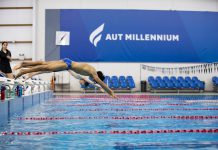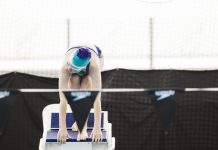Jumping in the pool for a workout can be hard when you’re not a natural swimmer. It could have been years since your last swim and decades since your last lesson. Swimming can provide numerous benefits for runners who want to improve performance or add variety in their training. Unlike running, which puts high loads the hip, knee and ankle joints, swimming is gentler on the body. Just because swimming doesn’t involve impact, it doesn’t mean it’s any less strenuous. Getting in the water can enhance running athleticism by challenging the cardiovascular system, improving breathing technique, elongating the body and strengthening core muscles. The weightless environment also helps to aid recovery.
Take Paul Lear, an avid runner and AUT Millennium Gym member. Paul incorporated swimming into his workout regime after his coach suggested it could improve his running performances at the Albany Lakes 5km series. Admittedly more adept on the land, Paul recalls being apprehensive about joining the AUT Millennium community swimming group. “I was actually really scared to join Adult Swim Squad, it took me a while. I didn’t think I could keep up.” After more than a year, Paul has become a regular face in the squad. He now leads his lane, has improved his 200m swimming personal best by more than ten seconds and has continued to refine his technique. Adding swimming to his athletic mix has paid dividends for the 45 year-old, who achieved his goal of winning his age group in the 2018 Albany Lakes series.
Five ways to help incorporate swimming into your regular workouts.
-
Start small
Swimming and running are very dissimilar movements. Even exceptionally fit runners may find swimming difficult when they first start out and that’s completely normal. Don’t be afraid to start small. Begin with a 15 or 20 minute swim and record your distance and how hard it felt. As with any exercise, frequency, intensity and time are all required for improvement. Starting small and tracking changes will help fuel motivation. Try approaching your swimming in blocks, swimming for the same duration for three weeks before increasing. You can play with intensity during each block, aiming to swim a little further or upping effort each time.
-
Be realistic
Understand ‘why’ you want to start swimming. Preparation is paramount when implementing a new activity. Write down where swimming will fit into your schedule and remember that it may be hard to begin with. Enjoy the challenge and keep track of your sessions. Having tangible evidence of your improvement will provide a shot of inspiration on days where you ‘just can’t be bothered’. Alternatively, a lack of improvement could be helped by a professional, such as a coach or teacher, who are able to give guidelines around training techniques and structure.
-
Give your body time to adapt
Humans are one of the most adaptable species on the planet, but adaptation takes time. Running and swimming recruit different muscles to move efficiently. When you start swimming, focus on comfort and body position first. Fighting through the water using the arms for power will fatigue your body quickly. Focus on taking a few deep, calm breaths before pushing off and keep your eyes on the bottom while swimming. Looking down will help your legs to float and promote a horizontal position – you don’t want to look like a sinking ship! ‘Front crawl’ is actually quite a confusing term because swimming power should initiate from a full body rotation that engages the shoulders, not relying on the arm muscles to crawl through the water. Remember, swimming is an opportunity for the legs to take a break and learning to swim efficiently is important.
-
Set a goal
Just ‘going for a swim’ often leads to disengagement and frustration. Setting a goal, even a small one, is important when starting a new exercise. The initial excitement of a fresh exercise may be enough to get started but a goal will help you to sustain enthusiasm. Simply aiming to ‘swim 1km without stopping’ or ‘swim 500m without feeling breathless’ is enough to spike motivation. Be as specific as you can when setting a goal, such as aiming for time (eg swim for 30 minutes), distance (swim 2km in the session) or effort (swim for 15 minutes at an 80% effort). Setting a goal will also give you the ability to adapt a plan instead of dropping an exercise completely.
-
Get a lesson or join a squad
Swimming is a complex motor movement that requires coordination of the entire body, so it’s important to take time learning the basic movement mechanics required. If swimming feels like a constant battle, it could come down to your technique. Swimming efficiently may only require a few minor changes to your stroke, which a coach or swimming teacher could help to correct. Enrol for a swimming lesson, join a squad or take a private session to gain a basic understanding of your swimming. Choosing to invest in professional advice can make swimming a lot more enjoyable. There’s a big difference between a constant fight and feeling like you’re gliding across the water.
Private swimming lessons, adult learn-to-swim and swimming squads are all available at AUT Millennium. Get in touch with the team today.
AUT Millennium Swim School
(09) 477 2074





































